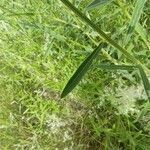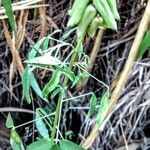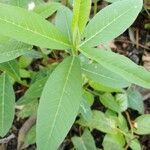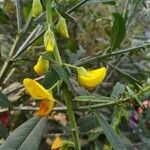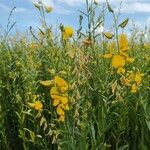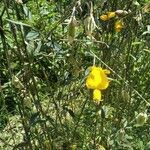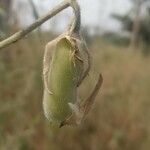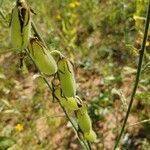Erect laxly branched annual to 1.5(-3) m; stem ribbed, appressed pubescent. Leaves simple; blade oblong-lanceolate, 6-15 x 0.5-3 cm, finely appressed pubescent on both surfaces, more densely beneath; petiole 3-5 mm long. Stipules filiform, 1-2 mm long. Racemes lax, 10-50 cm long, 6-20-flowered; bracts elliptic, acuminate, 3-5 mm long; bracteoles at the base of the calyx, linear, 2-5 mm long. Calyx slightly 2-lipped, 1.6-2 cm long, brownish tomentellous, with other longer hairs interspersed; upper lobes narrowly attenuate-triangular, 3-4 times as long as the tube. Standard elliptic to subcircular, bright yellow, faintly reddish marked, with scattered hairs outside; wings a little shorter than the keel; keel subangular, with a long slightly incurved twisted beak, 1.7-2.2 cm long. Legume subsessile, cylindrical, 3-5.5 x 1.2-1.7 cm, velvety tomentose, 6-12-seeded. Seeds oblique-cordiform, with the radicular lobe strongly incurved, 6-7 mm long, smooth to papillose around the hilum, very dark brown to black.
Herbs, erect, 50-100 cm tall. Branches terete, ribbed, appressed silky pubescent. Stipules linear, ca. 2 mm, caducous. Leaves simple; petiole 3-5 mm; leaf blade oblong to linear-lanceolate, 6-12 × 0.5-2 cm, both surfaces pilose but abaxially more densely so, base attenuate, apex acuminate and mucronate. Racemes terminal, 10-20-flowered; bracts linear, 3-4 mm. Pedicel 5-8 mm; bracteoles inserted at base of calyx tube, shorter than bracts, densely pubescent. Calyx 2-lipped, 1-1.5 cm, parted almost to base, densely rusty pilose; lobes lanceolate, curved. Corolla yellow; standard oblong, 1.5-2.5 cm, base with 2 appendages; wings obovate-oblong, 1.5-2 cm; keel subangular, slightly longer than wings, apex with a long slightly incurved twisted beak exserted beyond calyx. Legume subsessile, cylindric, 2-4 × 1.2-1.7 cm, 10-15-seeded, rusty pubescent. Seeds smooth to papillose around hilum. Fl. Aug-Dec, fr. Jan-May.
An evergreen shrub. It grows to 2.5 m high and spreads to 2 m across. The stem is erect, with silky hairs on the branches. The plant has a strong taproot. The roots have root nodules which have branches and lobes, and are 25 mm across. The leaves are narrow, simple and spirally arranged. The leaves can be 12 cm long and with short leaf stalks. The flowers are bright yellow and pea shaped. They occur in clusters of up to 20 blooms. The fruit is a short, inflated, light yellow pod. It is about 3 cm long and 1 cm wide. It is covered with soft hairs, has a groove on the upper surface and a beak at the end. The mature seeds are loose in the pod. They are dark grey, broad and flattened and hooked.
Standard elliptic to subcircular, bright yellow, faintly reddish marked or tinged, with scattered hairs outside; wings a little shorter than the keel; keel 1.7–2.2 cm long, subangular, with a long slightly incurved twisted beak.
Leaves simple; blade 6–15 × 0.5–3 cm, oblong-lanceolate, finely appressed pubescent on both surfaces, more conspicuously so beneath; petiole 3–5 mm long; stipules 1–2 mm long, filiform.
Calyx 1.6–2 cm long, slightly 2-lipped, brownish tomentellous, with longer hairs interspersed; upper lobes narrowly attenuate-triangular, up to 3–4 times as long as the tube.
Seeds 6–7 mm long, oblique-cordiform, with the radicular lobe strongly incurved, smooth to papillose around the hilum, dark brown to black.
Racemes 10–50 cm long, laxly 6–20-flowered; bracts 3–5 mm long, elliptic, acuminate; bracteoles at base of the calyx, 2–5 mm long, linear.
Erect laxly branched annual, up to 1.5(3) m tall; stem ribbed, appressed pubescent.
Pod subsessile, 3–5.5 × 1.2–1.7 cm, cylindrical, velvety tomentose, 6–12-seeded.
